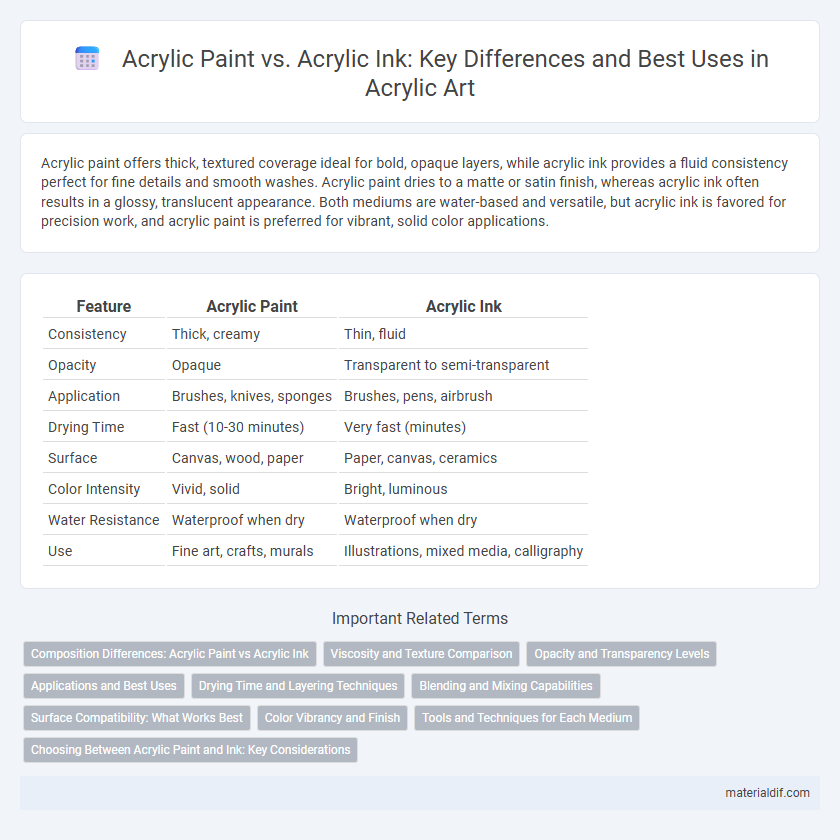Acrylic paint offers thick, textured coverage ideal for bold, opaque layers, while acrylic ink provides a fluid consistency perfect for fine details and smooth washes. Acrylic paint dries to a matte or satin finish, whereas acrylic ink often results in a glossy, translucent appearance. Both mediums are water-based and versatile, but acrylic ink is favored for precision work, and acrylic paint is preferred for vibrant, solid color applications.
Table of Comparison
| Feature | Acrylic Paint | Acrylic Ink |
|---|---|---|
| Consistency | Thick, creamy | Thin, fluid |
| Opacity | Opaque | Transparent to semi-transparent |
| Application | Brushes, knives, sponges | Brushes, pens, airbrush |
| Drying Time | Fast (10-30 minutes) | Very fast (minutes) |
| Surface | Canvas, wood, paper | Paper, canvas, ceramics |
| Color Intensity | Vivid, solid | Bright, luminous |
| Water Resistance | Waterproof when dry | Waterproof when dry |
| Use | Fine art, crafts, murals | Illustrations, mixed media, calligraphy |
Composition Differences: Acrylic Paint vs Acrylic Ink
Acrylic paint consists of pigment suspended in an acrylic polymer emulsion, resulting in a thicker, more viscous consistency suited for traditional brush application and textured effects. Acrylic ink contains finely ground pigment particles dispersed in a liquid acrylic medium, offering a much thinner, more fluid formula ideal for detailed work, airbrushing, and calligraphy. The difference in binder concentration and particle size directly affects drying time, opacity, and surface adhesion properties between acrylic paint and acrylic ink.
Viscosity and Texture Comparison
Acrylic paint features a thicker viscosity and textured consistency ideal for layering and impasto effects, allowing artists to build dimension on canvas. In contrast, acrylic ink has a much lower viscosity, flowing smoothly for fine lines, detailed work, and vibrant washes with a more fluid texture. The distinct viscosity difference impacts drying time and application methods, with acrylic paint providing more tactile surface texture compared to the sleek finish of acrylic ink.
Opacity and Transparency Levels
Acrylic paint offers higher opacity levels, making it ideal for covering surfaces with solid, vibrant colors and effectively hiding underlying layers. Acrylic ink is characterized by its transparency and fluid consistency, allowing artists to achieve delicate washes and fine details with visible layering effects. Understanding the balance between acrylic paint's opacity and acrylic ink's transparency is essential for selecting the right medium to achieve desired artistic textures and depth.
Applications and Best Uses
Acrylic paint offers versatility for canvas, wood, and fabric, excelling in textured and layered artwork due to its thicker consistency and opacity. Acrylic ink is ideal for detailed illustrations, calligraphy, and mixed media projects requiring fluidity and high pigment concentration for vibrant, precise lines. Artists choose acrylic paint for bold, textured effects and acrylic ink for fine details and fast-drying, transparent washes.
Drying Time and Layering Techniques
Acrylic paint typically dries within 15 to 30 minutes, allowing for easy layering and blending, while acrylic ink dries faster, often within 5 to 10 minutes, making it ideal for fine details and quick washes. Acrylic paint's thicker consistency supports building textured layers and impasto effects, whereas acrylic ink's fluid nature suits smooth, transparent layers and calligraphic strokes. Understanding these drying times and material properties helps artists choose the right medium for precise layering techniques and desired finish.
Blending and Mixing Capabilities
Acrylic paint offers robust blending capabilities due to its thicker consistency, allowing artists to achieve smooth gradients and rich textures on canvas. Acrylic ink, with its fluid and transparent nature, excels in precision detailing and layering but requires more skill for seamless color mixing. Both mediums complement each other, with paint providing depth and opacity while ink enhances fine lines and vibrant washes.
Surface Compatibility: What Works Best
Acrylic paint adheres well to a variety of surfaces including canvas, wood, paper, and fabric, offering flexibility for both traditional and mixed media projects. Acrylic ink, with its thinner consistency, excels on smooth surfaces such as paper, illustration board, and primed panels, providing vibrant, translucent layers ideal for detailed work. Choosing between acrylic paint and ink depends on the texture and absorbency of the surface, as paint covers more porous surfaces effectively while ink performs best on slick, non-porous materials.
Color Vibrancy and Finish
Acrylic paint delivers rich color vibrancy with a thick, opaque finish ideal for textured surfaces and layering techniques. Acrylic ink provides intense, translucent pigmentation that saturates the surface, creating bold, fluid color with a smooth, glossy finish. Both mediums offer excellent lightfastness, but acrylic ink excels in fine detail work due to its liquid consistency.
Tools and Techniques for Each Medium
Acrylic paint requires brushes with stiffer bristles or palette knives for thicker application and textured effects, making it ideal for traditional canvas work and layering techniques. Acrylic ink utilizes fine-tipped pens, airbrushes, or dip pens, offering precision for detailed line work, calligraphy, and fluid washes. Both mediums demand specific surfaces; acrylic paint adheres well to canvas and wood panels, while acrylic ink excels on smooth, non-porous surfaces like Yupo paper for vibrant, translucent results.
Choosing Between Acrylic Paint and Ink: Key Considerations
When choosing between acrylic paint and acrylic ink, consider the viscosity and coverage; acrylic paint is thicker and provides opaque layers suitable for textured, bold artworks, while acrylic ink offers fluidity and transparency ideal for detailed, vibrant illustrations. The drying time and surface compatibility also influence the choice--paint adheres well to canvas and wood with slower drying, whereas ink dries quickly and excels on paper and smooth surfaces for fine lines and washes. Pigment concentration and color intensity vary, with acrylic ink typically delivering more vivid hues due to its concentrated pigments compared to the thicker consistency of acrylic paint.
Acrylic Paint vs Acrylic Ink Infographic

 materialdif.com
materialdif.com